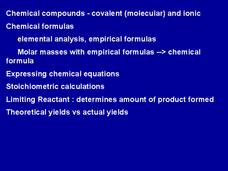Curated OER
Ranking Molecular Properties Based Upon Intermolecular Forces
A splendid chart of information about chemical bonding tops the first page. In it you will find information on London forces, permanent dipoles, hydrogen bonds, ionic bonds, and covalent bonds. A four-step process for assigning...
Curated OER
Chemical Compounds
Your young chemists will find these slides very informative. Groups and periods of the periodic table are labeled and described according to the charge. Comprehensive explanations of physical and chemical properties and how they relate...
Curated OER
VSEPR THEORY: BALLOONS AND MOLECULES
High schoolers listen to the teacher introduce VSEPR theory and explain molecular geometry. They use balloons to visualize the shape of orbitals. Students create visuals of molecular orbitals with strings and balloons.
Purdue University
Purdue University: Orbital Shells
This site from the Purdue University provides an overview of atomic orbitals and how quantum numbers specify these orbitals. Includes a model that can be rotated and examined in 3D. Includes learning exercises and answers.
Sophia Learning
Sophia: Electronegativity
Explore the concept of electronegativity and how it trends across the periodic table of elements. The author uses simple, humorous drawings to help with understanding.
Other
Chemtopics: Understanding the Schrodinger Eqn.
The Schrodinger equation specifies atomic orbitals which are occupied by an electron. Quantum numbers can identify a unique energy level for each electron (set up in a PowerPoint presentation).







